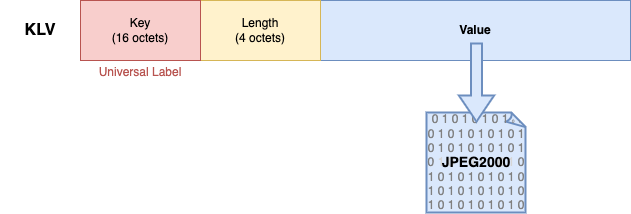
| References |
SMPTE 422-2014 - MXF - Mapping JPEG2000 Codestreams into the MXF Generic Container SMPTE 429-4-2006 - DCP - MXF JPEG2000 Application SMPTE 429-3-2007 - DCP - Sound And Pictures Track File 1 SMPTE 377-1-2011 - MXF - File Format Specification - RGBA Essence Descriptor (p148) SMPTE 384M-2005 - MXF - Mapping of Uncompressed Pictures into the Generic Container |
| KLV Model | Data Item |
| Universal Label |
060e2b34.01020101.0d010301.15010801 - Picture Essence, non-chiffré
060e2b34.02530101.0d010101.01012900 - RGBA Essence Descriptor
060e2b34.02530101.0d010101.01015a00 - JPEG2000 Picture Sub-Descriptor
|
In a DCP, images are stored one by one in their specific KLVs placed in the Body part: each frame is separated from the others and stored in a KLV named Picture Essence.
SMPTE chose to store each movie frame separately, without any link between the previous and the next image.
To simplify the concept, in encoding systems like H254, H265, MPEG, and other, several frames are just extrapolations of the previous frames in order to save space. At fixed interval, a complete reference frame is inserted. Picture this: to create movement from a still image, we overlay several transparent layers on top of the previous ones, each containing only the changes from the layer below.
This technical feature has been discarded for DCP because, if a frame is dropped, unacceptable artifacts will appear during theater projection. Each frame must be independent : if a frame is dropped, no big deal, the next one will be there to compensate this issue.
Note that in this chapter, we will focus exclusively on unencrypted MXF files. Thus, KLVs are of a specific type (Data Item) and each frame is unencrypted. In encrypted form, KLVs are slightly different. You may find explanations in the chapter on MXF Cryptography.
To store JPEG2000, we need some additional KLVs in the MXF headers :
The relationship between the RGBA Essence Descriptor & JPEG2000 Picture Sub-Descriptor is described below :
You can find the chapters on these two KLV headers :
Each frame is stored in a single KLV named "Picture Essence" : thus, we will have several (thousands for a complete movie) of KLV named "Picture Essence".
Its Universal Label is 060e2b34.01020101.0d010301.15010801 which is structured as follows :
Each last octet (byte) represents a status :
The Picture Essence KLV is the simplest of the KLVs: all you need to dos is read the entire Value of the KLV which integrates the entire frame, from the JPEG2000 headers to the picture data. You have the entire JPEG2000 content file ! No processing needed, no conversion required. Thus, the JPEG2000 file is an 12-bits X'Y'Z' image file.
You can save the content of the Value of KLV directly as a JPEG2000 J2C file.

Source code to read the KLV Picture Essence and extract them :
import sys
# Integer Conversion
def to_int(length : bytes = b'') -> int:
return int.from_bytes(length, byteorder='big')
if len(sys.argv) < 2:
print("Usage: %s <mxf>" % sys.argv[0])
sys.exit(1)
mxf_file = sys.argv[1]
with open(mxf_file, "rb") as file:
while True:
# Key : Universal Label
key = file.read(16)
# End of file
if not key:
break
# Length (BER format) (quick & dirty, see KLV chapter why)
length = to_int(file.read(4)[1:]) # BER format - read last 3 bytes
# Value
value = file.read(length)
# Filter by KLV "Picture Essence"
if key.hex() != "060e2b34010201010d01030115010801":
continue
# Show each KLV
print("{key} - {length:>6d} bytes - {value}...".format(
key = key.hex(),
length = length,
value = value[0:16].hex()
))
# write Plaintext to file
filename = "output_%d.j2c" % file.tell()
print(f"Extract {filename}")
with open(filename, "wb") as f:
f.write(value)
The source code isn't complicated, all you need to do is step through each KLV, and when a KLV Picture Essence is detected, just read the Length field and read the Value field.
The advantage of the KLV Picture Essence JPEG2000 is that the entire content of the JPEG2000 is stored in the Value field. All you need to do is extract the raw data and save it to a file to have a complete, ready-to-use JPEG2000 file.
Note that everything you have read in this chapter - including the linked KLV RGBA Essence Descriptor & JPEG2000 Picture Sub-Descriptor - will apply to the chapter on MXF Cryptography as well (except that Essence Container should be replaced by Encrypted Essence Container)
See the chapter XYZ Colorimetry
See the chapter JPEG2000
See the chapter Essence Picture : Stereoscopic (3D)
See the chapter Essence Picture : High Frame Rate (HFR)
Track Files shall use the MXF Generic Container (GC) SMPTE 379M. Track Files shall use GC frame-based essence mappings -- SMPTE 429-3-2007 - DCP - Sound And Pictures Track File ↩